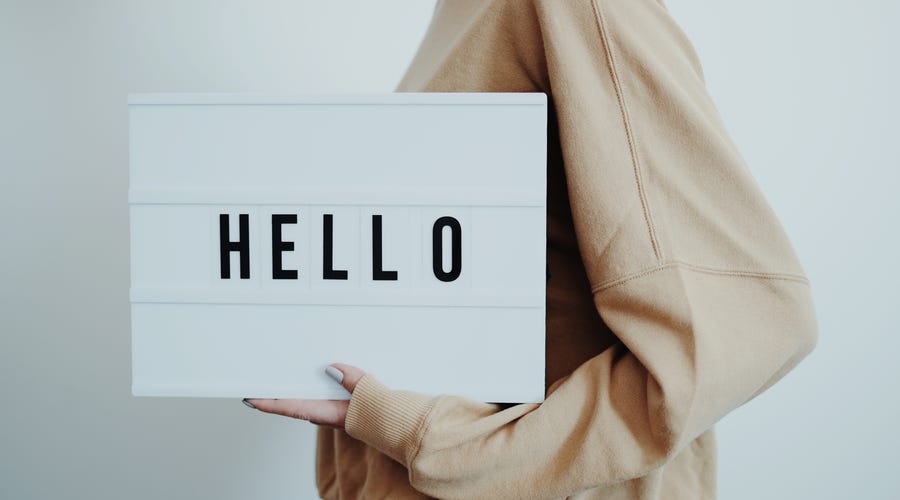How Do You Say Hi in a Funny Way

107 interesting and different ways to say hi in English
How do you say hello in English when you need to be formal, but you also want to convey enthusiasm? And how do you greet someone in English if you've never met them? Is there a difference between hi there and hey you, and why does the same greeting change meaning when spoken in a different way?
It's vital to be able to recognize and understand the different contexts of how we say hello in English.
This article will explore the many ways we say hello in English and will look at the unspoken and subtle wealth of meanings that accompany our greetings and how you can learn to recognize and use them.
How do you actually say "hello" and "hi" in English?
"Hello" is pronounced /həˈloʊ/, and "hi" is pronounced /haɪ/. Both are exclamations; we pronounce them strongly and clearly because we use them to signal for someone's attention.
However, hello and hi can carry extra meaning. This is because we naturally intensify our greetings if we know someone or cool our greetings if we are uncertain about them.
107 ways to say hi in English
It's incredible that we can express so much with a single greeting!
Let's go casual
| Greeting | Pronunciation | Context |
| Hi | hy | We know the person well, and we see them quite often |
| Hi there | hy thehr | We know the person well but have not seen them so recently |
| Hey | hay | We know the person very well |
| Hello | heh low | We know the person, but not so closely |
| Hey you | hay yoo | We know them so well, we can become playful |
| Hi (person's name) | hy | We know the person and like them very much |
Let's go formal
| Greeting | Pronunciation | Context |
| Hello, nice to meet you | heh low | You don't know the person |
| Hello, nice to see you | You know them, but not very well | |
| Hello, how are you doing? | You know them in a formal and regular situation, such as at work | |
| Hello Sue, how are you? | You know them a little more closely enough to use their name | |
| Hello there | You know them but haven't seen them for some time |
Do greetings change at different times of the day?
They do, but to mix these up is often ok, and even useful as an "icebreaker" for a formal conversation:
- Good morning/evening/afternoon are quite formal, but morning/ afternoon/evening are casual.
- Goodnight is the same as goodbye, and is not used as a greeting
- We use good morning, how are you when we know the person
- We use morning when we are in a hurry or not planning to stop and chat
- We say good morning or is it afternoon already as polite conversation and as a humorous reference to being so busy that we don't know what time it is.
Do our greetings change if we know the person we are addressing?

They certainly do, and they change even more if we like that person.
- Hi will become hiiiiiiii. We lengthen and add volume to the end of the word. This signifies pleasure and warmth.
- Hello becomes helloooooo . Again, we lengthen and emphasize the word. Using hello instead of hi can also indicate that we really like this person but haven't seen them for a while.
- Hey becomes heeeey. We emphasize this form to get someone's attention who we like.
- Hey you or hey you there spoken with an emphasis on the you signals that we know them. However, this form can also signal displeasure.
- Howdy / Hey mate / Hey man / G'day / and Gidday mate all indicate that we know a person quite well.
- How are you? / What's up? / How's it going? are casual ways to say hello in English and indicate that we've known that person for some time.
- How's you? is a casual and tender way to ask after someone's wellbeing. It indicates that you know them well.
Greetings in English to use when you haven't seen that person for some time
- Long time no see
- Heeeeeey, good to see you
- Hellooo, how are you?
- Hey, is it really you?
- Is that you?
- Is that seriously you?
- Hello stranger!
- Are you kidding me?
- This can't be true!
How to say hello in English when you've never met the person before
- Nice to meet you. This is simple and courteous. You would use this form in a new English class, for example, when you are attending in person.
- So nice to meet you
- I've been looking forward to meeting you
- I've heard so much about you
- Hello and welcome. You would formally greet a group this way.
How to say hello on the phone, in a text, or email

- We use hello, hi, and our name on the phone. If we know the person, we might say hey, it's me or just hi because the other person likely has us listed in their phone.
- In a formal text, we always use hi or hello. For an informal text, we don't use any greeting because texting with people we know is usually a continuing conversation.
- We always use Hi for emails, or Dear… if it is very formal.
How to say hello while also emphasizing something else
- Hello again – we use this to greet someone we have only met once before; we say "again" to emphasize that we remember them.
- Well hello! – we use this to greet someone we've only met once, but very much liked.
- Helloooooo – this is a written form, and is used in short messaging as a greeting, but also to query an absence (where have you been all this time?)
How we say hello in English when the situation is tricky and we aren't sure how we feel about it
English is full of voice tones and gestures that express courtesy. These are vital to keep conversations smooth and flowing and can also prevent conflict.
For example, when we greet someone we don't like much, we often say, hiiiiiiii with a lilt. This sing-song tone can express tension and uneasiness and can be used to express enthusiasm that we don't actually feel.
- Hiiiiiii, fancy meeting yuuuu here
- Heeeey, how r yuuuuu
- Oh My God….I did NOT expect to see you here!
- Oh wow. Ok. Hi…
- Oh hello. Sorry, I didn't expect to see you!
When we've had a falling out with someone, we might say hello or hi in clipped tones that do not invite further conversation.
- Hey.
- Hi.
- Hello.
- A nod (with nothing actually spoken)
- A smile (and nothing actually spoken)
- A stiff smile (and then look away)
How to say hello in English in other English speaking countries
What all of these forms have in common is each one is simply stating "hello". The question format is irrelevant; we aren't asking an actual question, and we don't expect any other answer except "hello" or a format that means "hello".
| Like a Brit | Like an American | Meanwhile in Australia |
|---|---|---|
|
|
|
| Like the Irish | In New Zealand | And in Scotland |
|---|---|---|
|
|
|
FAQs about saying hello in English
What are some English greeting faux-pas?
To greet a formal acquaintance very casually can cause discomfort, while to greet close friends over formally signals that something is wrong, and they may ask you if everything is ok.
To add physical touch to your greeting must be handled carefully. We usually only greet with a physical gesture if we know the person very well.
What is the best way to practice greetings in English?

The most effective way to learn how to say hello in English is to use these greetings in real life groups. A great way to do this is to join a group class, for example.
Why are knowing English greetings so important?
Saying hello in English is how we begin every interaction. Greetings set the scene and can influence the tone of the rest of the conversation; a faltering conversation can be difficult to continue.
Getting our greetings right feels good and starting well can make up for mistakes we might make later in the conversation.
Learning to say hello in English is a useful skill and a vital part of successful interaction with others. English has many different greetings, and a variety of ways to express them.
Pay attention to conversations and practicing expressions, and you'll develop a repertoire and manage conversations with comfort and ease.
Related Articles
Fill in the form below and we'll contact you to discuss your learning options and answer any questions you may have.Find out more
Source: https://www.berlitz.com/blog/hello-in-english
0 Response to "How Do You Say Hi in a Funny Way"
Post a Comment